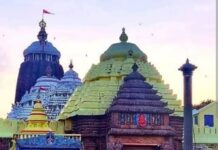By Anil Dhir
BHUBANESWAR: In 2013, just prior to the Rath Yatra, the Sankaracharya of Gobardhan Peeth, Swami Nischalananda Saraswati, had written a letter to the centre, requesting the government to intervene and press officials in Nepal to provide the Kasturi needed for the Lord’s worship.
Kasturi, a substance collected from the navel of the musk deer, is used for the various shingars of the Trinity. It is used in the Mukha Shringar of the three deities during the Nabjauban Darshan and Hera Panchami. As a necessary shingar aid of the divinities, kasturi comes in handy at the time of gupta seva (secret service) during the Ansar rituals when the deities are taken sick ahead of the car festival.
In earlier years, after the ceremonies, the temple air used to be is thick with the sweet spicy scent of musk. So intense was the smell, that even days after it had been applied, the scent pervaded the air inside the sanctum sanctorum of the temple.
Kasturi is supposed to be applied to the deities for mukha sringar every Wednesday, but over the years, due to its scarcity, it has become a monthly ritual. According to the shingaris, who have the honour of applying the paste on the deities, approximately five grams of the kasturi powder is mixed along with camphor, asafoetida and other different herbs. The paste is then applied to the faces and bodies of the three gods, as these help keep the wooden images insect-free. These rituals also have a scientific base apart from having religious significance.
Since the last few years, there has been an acute shortage of the rare and invaluable ‘kasturi’ at the shrine, giving sleepless nights to the temple servitors and authorities. The present shingaris have protested that since the last few years, just powder with artificial additive is being used instead of kasturi.
Tradition has it that Nepal’s royal family, who enjoy special privileges at the Jagannath temple, arranged to have the much needed kasturi sent to Puri for the Lord. Since the fall of the monarchy in the Himalayan kingdom, Nepal’s new rulers have been unresponsive to the temple’s request for the regular supply of this rare aromatic.
The once abundant stock of musk in the Jagannath temple depleted with each passing year as the supply from Nepal stopped completely. Temple sources said the last official supply of musk from the Royals of Nepal was in 1999. In the 80’s, King Birendra and Queen Aishwarya had visited the shrine with a huge stock of musk, which lasted for years. In 2006, the temple authorities were surprised when a visiting mendicant gave a few pods to the Lord.
Musk deer or the kasturi mrigya, the only source of musk, is found in the Himalayan region, including Nepal. It is an endangered animal and figures in the Red Data List of the International Union of Conservation of Nature. The musk deer is a Schedule 1 animal and is protected under wildlife laws both in India and Nepal. Musk is the name originally given to a substance with a penetrating odor obtained from a gland of the male musk deer. To obtain the musk, the deer is killed and its gland, also called the “musk pod”, is removed. The substance has been used as a popular perfume fixative since ancient times and is one of the most expensive animal products in the world.
The authorities in Nepal, who are aware of the problem, express their helplessness. The strong links that the Nepalese Monarchy has with the Jagannath temple since antiquity is well known and accepted. The Nepalese maintain that it is not possible to supply kasturi since it is illegal as per the Wildlife Act.
They have also said that India has the option to source the rare perfume, as musk deer are found in Himachal Pradesh and Arunachal Pradesh. The Nepalese Guthi Sansthan had earlier helped the Puri temple by supplying kasturi. The Sansthan is of the opinion that the Nepalese government should take the initiative to keep the age-old Nepal-India cultural and religious relationship intact. They had sent a few pods before the Nabakalebar of 2015.
The Jagannath cult is deeply rooted in tradition, something that has been maintained over the centuries. Keeping this in mind, concrete steps should be taken to captive breeding of the deer to prevent its extinction. The possibility of scientific extraction of the musk pods without killing the deer should be explored. Musk is used in traditional Chinese medicine, and rampant poaching has decimated the population in its natural areas. Some experts say that when the temple is faced with a crunch at a later stage, they may have to think in terms of an alternative.
(The writer Mr Anil Dhir , is an Eminent Historian, Researcher on Culture and Ancient Heritage and senior Member , INTACH, Odisha. Views expressed are personal)





























